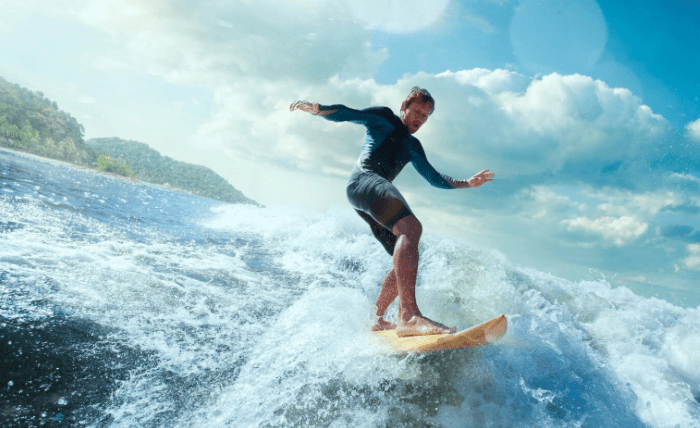There’s a moment in kite surfing that hooks you forever. You’re riding along, the board skimming across the water, and then suddenly the kite lifts you up. For a few seconds, you’re weightless, suspended in mid-air with nothing but the wind holding you. Then you land, heart racing, and do it all over again.
That’s kite surfing in a nutshell—a perfect blend of speed, power, and freedom. If you’ve ever watched someone launch 20 feet into the sky on a windy beach and thought, I want to try that, you’re not alone. Kite surfing is one of the fastest-growing water sports in the world, and it’s easy to see why.
What Exactly Is Kite Surfing?
Kite surfing (or kiteboarding) is a mix of surfing, wakeboarding, and paragliding. You use a large kite to catch the wind, and that pulls you across the water on a small board. The kite is connected to you through a harness and control bar, so you can steer it with small hand movements.
Unlike surfing, you don’t need waves. If there’s wind and water—whether it’s the ocean, a lake, or a flat-water lagoon—you can kite surf. That makes it possible in places you’d never expect, from mountain reservoirs to breezy bays.
Why People Get Addicted
The first time you get up on the board, it’s like learning to ride a bike. A little wobbly at first, but once you figure it out, you’re off. And then there’s the jumping. Learning to use the kite to launch yourself into the air is an experience like no other.
But it’s not all about adrenaline. Kite surfing can be as mellow or as extreme as you want it to be. Some riders like cruising along at a steady pace, soaking up the scenery. Others love chasing big air and learning tricks. Either way, you get a sense of freedom that’s hard to find anywhere else.
The Gear You’ll Need
Kite surfing gear can look intimidating, but it’s actually pretty straightforward once you break it down:
- The Kite: Inflatable kites (the most common type) are designed to float on the water if they crash.
- Control Bar: This is how you steer and control the power. It’s connected to the kite with strong lines.
- Harness: Worn around your waist, it takes the pull off your arms and lets you ride comfortably.
- The Board: Beginners usually start with a twin-tip board, which works in both directions.
- Safety Gear: A helmet, flotation vest, and a quick-release system for the kite are must-haves.
Most schools and rental shops provide all the equipment, so you don’t need to buy anything when you’re starting out.
How Hard Is It to Learn?
Here’s the truth: kite surfing takes some time to learn, but it’s not as difficult as it looks. You’ll spend the first day on the beach learning to control the kite before you even touch the water. Then you’ll practice body dragging (using the kite to pull you through the water without the board) before moving on to riding.
Most people need at least a few days of lessons to get the hang of it. Once you can stand up and ride a short distance, the learning curve gets much faster. Before long, you’ll be cruising upwind, turning smoothly, and maybe even trying small jumps.
Fitness and Health Perks
Kite surfing is a full-body workout disguised as fun. It works your core, legs, and upper body while improving balance and coordination. Because the kite takes most of the pull, it’s easier on your joints than other sports.
Mentally, it’s a great way to unplug. You can’t think about work or your phone when you’re trying to read the wind and control a kite. And after a session on the water, you’ll feel both exhausted and recharged at the same time.
Where to Go Kite Surfing
The beauty of kite surfing is that it’s global. There are legendary spots all over the world:
- Tarifa, Spain: Reliable winds and a buzzing kite community.
- Le Morne, Mauritius: Stunning turquoise lagoons with steady trade winds.
- Cape Town, South Africa: For big air and epic downwinders.
- Cabarete, Dominican Republic: Great for beginners and advanced riders.
- Maui, Hawaii: Kite Beach is a mecca for experienced riders.
If you’re not near the ocean, don’t worry. Many riders kite surf on lakes, rivers, and even wide bays with flat water.
Safety First
The kite has a lot of power, so safety is a big deal. Always take lessons before going out on your own. Know how to use your quick-release system, check the weather, and never ride in offshore winds (they’ll blow you away from shore).
And remember, you’re sharing the water with others. Give swimmers and other riders plenty of space, and respect local rules.
The Community
One of the best parts of kite surfing is the people you meet. Beaches and kite spots naturally turn into hangouts where everyone helps each other out—launching kites, swapping stories, and celebrating big jumps.
There are also festivals and competitions around the world, from amateur gatherings to professional events where riders pull off jaw-dropping tricks.
Ready to Try It?
Kite surfing isn’t a sport you pick up in a single afternoon, but that’s part of the appeal. It’s a challenge, and when you finally nail a ride or a jump, the sense of accomplishment is huge.
If you’re ready to try it, book a lesson at a local kite school. They’ll teach you the right way from the start, and you’ll be hooked before you know it.
Final Word
Kite surfing is more than just a water sport—it’s a lifestyle. It’s about chasing wind, exploring new places, and pushing your limits. And once you feel that first lift into the air, you’ll understand why so many people fall in love with it.

